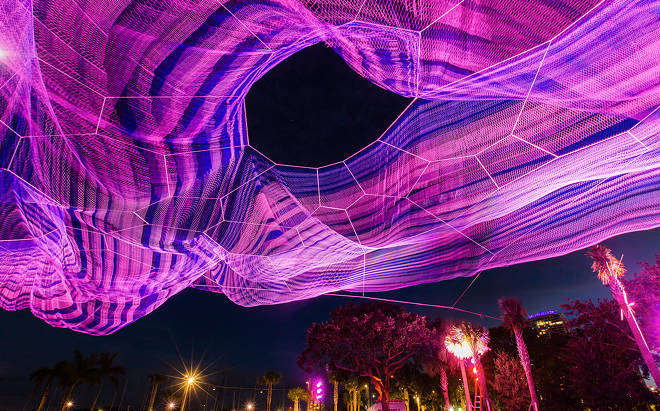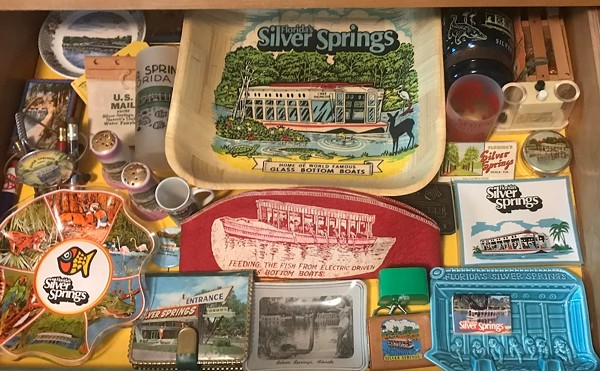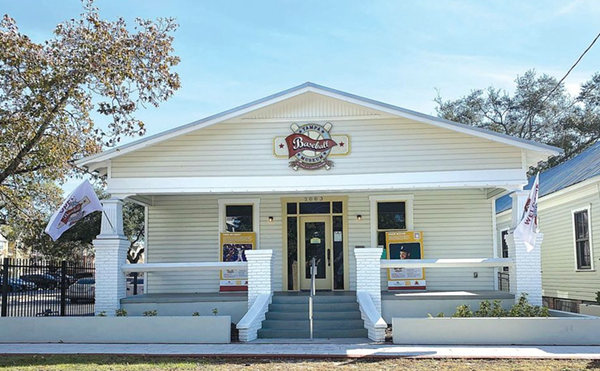Sculptor Janet Echelman titled her new installment on St. Petersburg’s Spa Beach “Bending Arc,” and with that she invoked Dr. Martin Luther King and his famous quote, “The arc of the moral universe is long but it bends toward justice.”
When she researched the Spa Beach location for her new installation on the Pier, she discovered in 1954 powerful Jim Crow laws governed the city, inspiring the name “Bending Arc.”
Today, in this place, some are asking how much further the arc must bend before reaching justice? True, the civil rights battles of the 1960s ended Jim Crow segregation, but protesters on the new Pier are still demonstrating against police brutality, a fight that MLK brought to the streets. The battle never ended. Echelman’s name choice carries echoes of the past, but is that conflict too distant for most people to connect it with her sculpture in the here and now?
With “Bending Arc” in St. Petersburg, she hopes viewers get the message when they experience it. Seen against the night sky, illuminated with bright blue, pink, and white lights, she hopes visitors and residents will feel a deeper connection for public spaces and their city.
St. Petersburg historians doubt that visitors will see a billowing, colorful net wafting in the wind and think of desegregation. In 1955, African Americans sued the city for the right to use municipal Spa Beach and Pool. City Manager Ross Windom retaliated by closing the pool for “repairs” rather than allowing integration.
The case, Fred Alsup v. St. Petersburg, went all the way to the United States Supreme Court, which refused to hear the city’s appeal and thus upheld Black St. Petersburg residents’ rights to use the beach. In 1958, Mayor John D. Burroughs responded to the ruling, “I like the Negro. I like him in his place. I do not believe in integration.”
When I visited the site I didn’t see a plaque giving this history. The plaque in front of the sculpture celebrates the current inclusiveness of the beach, but it doesn’t directly reference the background.
Gwendolyn Reese, president of the African American Heritage Association of St. Petersburg told Creative Loafing Tampa Bay, “There is no mention of the struggle for desegregation on that beach. There is no connection between the sculpture and the quote.” Before COVID-19, Reese led regular tours of the African American Heritage Trails in St. Petersburg to help preserve Black history and educate residents.
“At this particular time,”Reese added, “there is so much of history that is unknown. It’s disappointing that the city didn’t take the opportunity to tell both sides of that history, even the dark side of history.”
Carla Bristol, a community activist who participates in nightly protests on the Pier and on city streets, has visited the sculpture multiple times.
“I don’t see anything [connected to the sculpture] that suggests that there may have been dialogue between Echelman and the Black community. If it’s going to be promoted as a healing sculpture, there should have been better outreach.”
In July, when pier-goers and and some outlier protesters clashed, the Tampa Bay Times’ editorial board—Elizabeth Dijinis and four white men tasked with being the “institutional voice” for the Bay area’s vaunted paper of record—asked protesters to, “Take your skateboards and go home,” adding that, “The leverage of social justice is working. There’s no sense in becoming the problem or overplaying one’s hand.”
Bristol observed that when she saw “Bending Arc” recently, a football was stuck in it; she also thinks it’s unfortunate that people can’t see the dramatic nighttime lighting from outside the immediate Spa Beach area. On a positive note, when she was there recently, a drum circle was performing under the net.
“People’s energy was incredible, and it felt like a welcoming space,” Bristol added.
University of South Florida professor of English, author, and civil rights scholar Julie Armstrong, noted, “I'm glad to see that the sculpture's description alludes to the location's history, although I would also like to see, at the bare minimum, a historical marker that provides more specific details. The way I see it now, the piece's title and its allusion to Spa Beach provide a self-congratulatory, feel-good story for Pier visitors without doing the actual work of truth-telling, making amends for the past, or addressing current inequities that have their roots in St. Petersburg's history of segregation.”
In an email to CL, City of St. Petersburg spokesperson Benjamin Kirby said no one has made a request for such a plaque explicitly acknowledging the segregated past and struggle surrounding Spa Beach.
"It is also important to remember that the Pier, including Spa Beach, is for everyone. The mayor raised a great deal of money to have this work, entitled 'Bending Arc' installed, and accessible to all," Kirby added, noting that unfortunately Spa Beach was not the only segregated place in St. Pete. "That said, we have a well-documented history, and we'll continue to build a city of opportunity."
In numerous interviews, Echelman, a Tampa Bay native, said she wanted to honor that civil rights history with the MLK quote. The artist told Fast Company, that her work represents strength through resiliency and flexibility, qualities she believes she captured with the medium.
“I think that’s a metaphor for how to live in these times,” Echelman said.
“One of the most exciting parts about public art is not only its potential for community engagement, but also its ability to address the historical context of its site,” Katherine Pill, MFA Curator of Contemporary Art, told CL.
In a divided country, Echelman’s message of unity seems especially timely. To create the net, the artist tied over 1.5 million knots and twisted 80 miles of hand-spliced polytetrafluoroethylene (PTFE) fiber into twine. The net metaphor suggests that it takes many hands and miles of string to weave a strong and flexible social fabric. Openings are strategically incorporated within the netting to suggest gaps, and invites the question, “who or what is slipping through?” But, is that too abstract a connection for most people to make?
Echelman began studying cities in 2011. Six years later, in an interview for Adobe Create Magazine, she described the process of building a net and her artistic philosophy.
“I’m trying to understand the identity the city wants to become,” she said.
Adding a plaque shining a light on Spa Beach’s Jim Crow history, and acknowledging that it was the site of government sponsored racial segregation would make long strides toward justice and diversity in the new 2020 Pier District.
Support local journalism in these crazy days. Our small but mighty team is working tirelessly to bring you up to the minute news on how Coronavirus is affecting Tampa and surrounding areas. Please consider making a one time or monthly donation to help support our staff. Every little bit helps.
Subscribe to our newsletter and follow @cl_tampabay on Twitter.




















